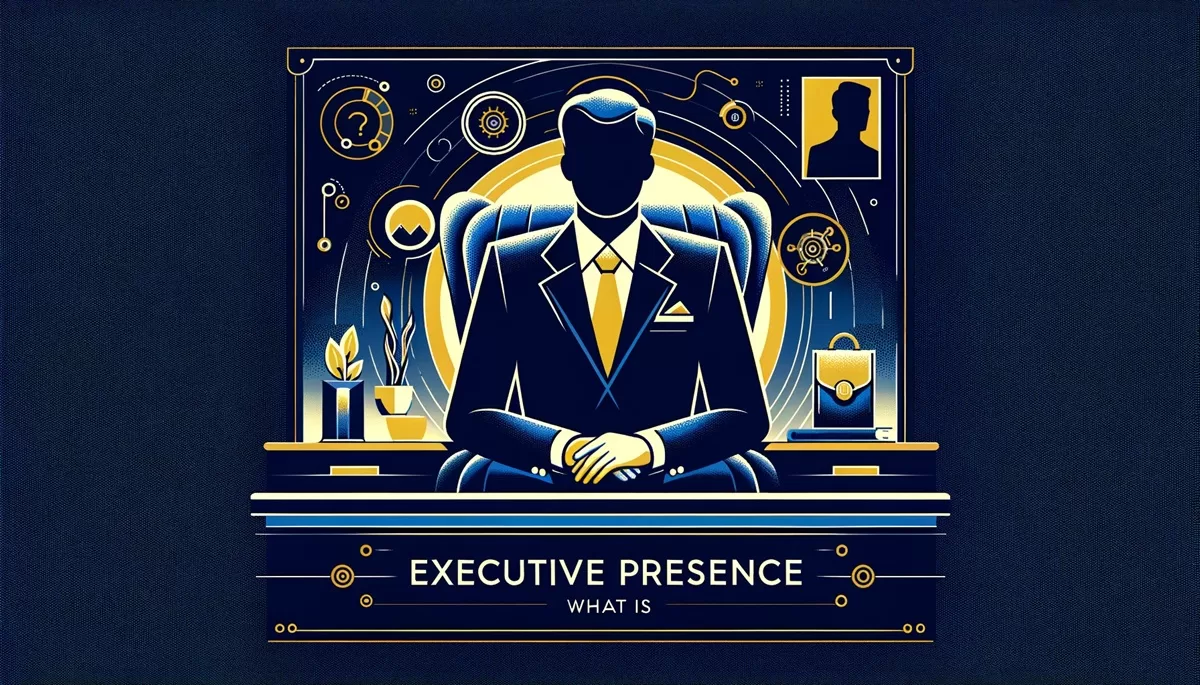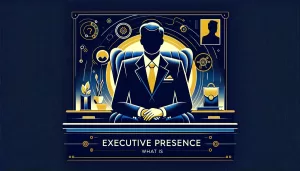Imagine walking into a high-stakes meeting, feeling an invisible aura of command that effortlessly sways opinions and decisions in your favor.
How do you achieve that magnetic force?
The answer lies in the elusive art of executive presence.
Contents
- 1 What is executive presence?
- 2 What are the components of executive presence?
- 3 How do you show executive presence?
- 4 Tommy Shelby in Peaky Blinders
- 5 What is another word for executive presence?
- 6 What is poor executive presence?
- 7 What is a real-life example of executive presence?
- 8 Cultivating Your Executive Presence
What is executive presence?
Executive presence is your ability to influence people and situations when the stakes are high.
It’s how you cause an effect in rooms, situations, and people by showing up.
It’s the way you react to difficult questions, high pressure, and stressful situations.
It’s about the way you dress and move your body and it is also about your mindset and micro expressions.
It’s about inspiring confidence, or fear, when you need to.
“Executive presence” (EP) is a topic I’ve been obsessed with since I moved to the United States to attend an MBA program at the C.T. Bauer College of Business.
I’ve read many books on this topic, gone through a lot of theater training and public speaking training, and I’ve had to put what I’ve learned into practice to build my own executive presence as I navigate the business world as an introvert and immigrant.
I want to share what I’ve learned with you so that you can make your learning curve a bit shorter.
In this piece, I will go over:
- The basics of understanding “what is executive presence” and
- How you can start crafting your executive presence
What are the components of executive presence?
We can divide the components of executive presence into two categories: external and internal.
The external components are:
- The way you look
- The way you move
- The words you use
The internal components are:
- Your confidence
- Your capacity to read others
- Your ability to respond instead of react
Executive presence is a blend of how you speak, look, and act. It’s your overall demeanor that whispers to the world, “I’m in charge.”
Here are some of the specific components of executive presence:
- Body Language: Stand tall, sit straight. Your posture should scream confidence.
- Style: Dress the part. Sharp but not over-the-top.
- Language: Speak their language. Simple, clear, and powerful.
- Eye Contact: Lock eyes, not in a creepy way, but enough to show you’re focused and confident.
- Handshake: Firm, brief, and impactful. It’s your first physical interaction, make it count.
- Storytelling: Your ability to captivate by telling interesting stories.
How do you show executive presence?
Let’s dive into some examples to see executive presence in action:
Miranda Priestly in The Devil Wears Prada
With just a glance, Miranda could send a chill down the spine.
Her minimalistic yet powerful speech, impeccable style, and commanding presence make her an EP icon.
Let’s delve into a high-stakes scene that perfectly encapsulates her commanding aura—the moment Miranda gives Andy a fashion masterclass for laughing over two seemingly identical belts for an outfit.
As the scene unfolds, the air in the room is thick with anticipation, each team member on edge, understanding the weight of Miranda’s approval.
The atmosphere is electric, charged with unspoken anxiety, as assistants scurry, their movements sharp and quick, a physical manifestation of their inner turmoil.
Miranda’s gaze, sharp and discerning, cuts through the pretense, her eyes scanning the options laid before her.
The room holds its breath, the only sound the soft rustle of fabric as she assesses the belts. Her expression is unreadable, a masterclass in control and restraint, her composure unshakable despite the palpable tension.
When she finally speaks, after Andy explains why she laughed, her voice is cool, and measured, each word delivered with precision, slicing through the silence.
In that moment, Miranda demonstrates the essence of executive presence—not just in what she says, but in how she says it. Her language is simple, her directive clear, leaving no room for doubt or debate.
The reaction from her team is immediate, a mixture of relief and awe. They scramble to comply, their movements now purposeful, energized by the clarity of her decision.
Miranda’s executive presence in this scene is a complex tapestry woven from her style—impeccable and intimidating, her body language—poised and dominant, and her use of language—minimal yet impactful.
She exudes a quiet power that demands respect and obedience, not through loud declarations or overt displays of authority, but through her unshakeable confidence, her ability to make decisive choices under pressure, and her subtle yet undeniable command of the room.
This moment is a masterful portrayal of leadership, a reminder that true power lies not in volume or ostentation, but in the quiet assurance of knowing who you are and what you want.
Tommy Shelby in Peaky Blinders
He is a man of few words, but when he speaks, the world listens.
His stern gaze, calm demeanor under pressure, and strategic silence showcase a magnetic executive presence.
A defining moment of his enigmatic leadership is his first meeting with Alfie Solomons, a scene thick with tension and the unsaid, a chess game played in the grimy backrooms of early 20th century Birmingham.
As Tommy steps into Alfie’s domain, the air is laden with the smell of the distillery, a heavy, intoxicating mix of yeast and wood.
Tommy’s voice, when he speaks, is soft yet carries an undercurrent of steel.
His Birmingham accent, pronounced, adds a layer of authenticity and grit to his words.
He doesn’t waste words, each sentence is precise, a testament to his strategic mind. His gaze never wavers from Alfie’s, a clear challenge, an assertion of his presence and power.
Alfie, initially amused by Tommy’s audacity, soon recognizes the steel beneath the calm exterior. Tommy’s executive presence is not loud or overt; it’s in his unflinching eye contact, his controlled posture, and the calm, even tone of his voice.
He exudes confidence, not through aggression, but through a quiet certainty in his own power and intellect.
This meeting between Tommy Shelby and Alfie Solomons is a masterclass in executive presence.
Tommy commands respect not by demanding it, but by embodying it.
He demonstrates that true power lies in restraint, in the unspoken threat, and in the calm before the storm.
His executive presence is his weapon.
What is another word for executive presence?
Executive presence is often cloaked in synonyms like poise, owning the room, or swagger.
Each term dances around the same fire: the ability to captivate, influence, and hold power in any room.
It’s about exuding confidence without saying a word, making people listen when you do speak, and inspiring trust and admiration through your actions and aura.
What is poor executive presence?
There are some actions that can erode your executive presence.
Talking too fast, fidgeting, and trying to fill every silence are all signs that you are not comfortable with difficult conversations and high-stakes situations.
You must stay away from these as they will signal poor executive presence.
What is a real-life example of executive presence?
There are many people who are great real-life examples of executive presence.
Here are a few:
Abraham Lincoln
Lincoln’s deep voice, towering stature, and ability to tell compelling stories made him unforgettable.
His calm under pressure and his thoughtful communication style exemplified executive presence.
Jeff Bezos
Bezos commands attention with his laugh that fills the room and concise, data-driven communication.
His relentless focus and visionary outlook are key components of his EP.
Angela Merkel
Known for her stoic composure, Merkel’s executive presence is defined by her pragmatic approach, resilience, and ability to remain unflappable under pressure.
These leaders, each unique in their way, share a common thread—exceptional executive presence.
They embody the essence of EP through their confidence, communication, and composure, influencing millions and leaving indelible marks on history.
Cultivating Your Executive Presence
Executive presence isn’t an innate trait.
It’s a skill you can develop.
Start by observing leaders you admire, noting how they speak, act, and interact with others. Practice your speech, refine your style, and remember, confidence is key.
With dedication and self-awareness, you, too, can develop an executive presence that opens doors and makes people take notice.
In the end, executive presence is about how you make others feel when you walk into a room and after you’ve left it.
It’s the legacy of your leadership style.
By honing your executive presence, you not only enhance your career prospects but also become a more effective, inspiring leader.





